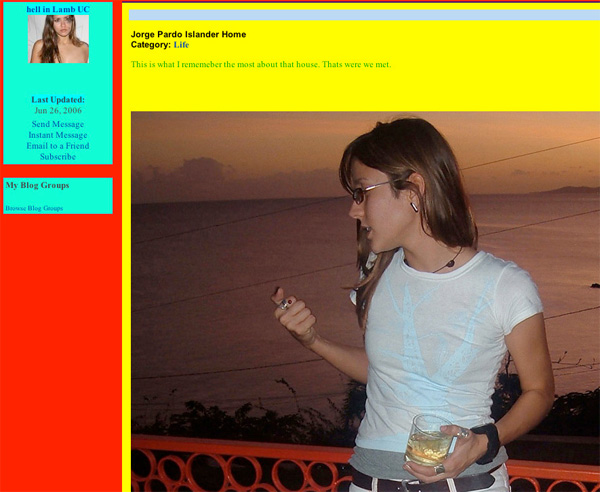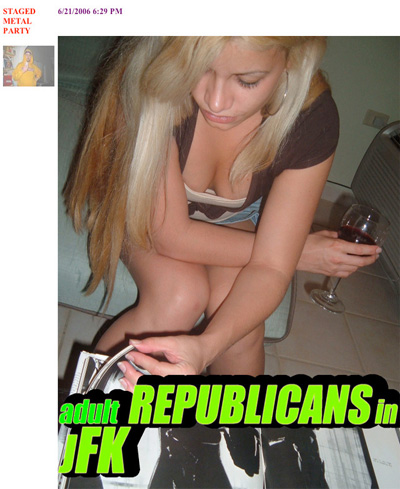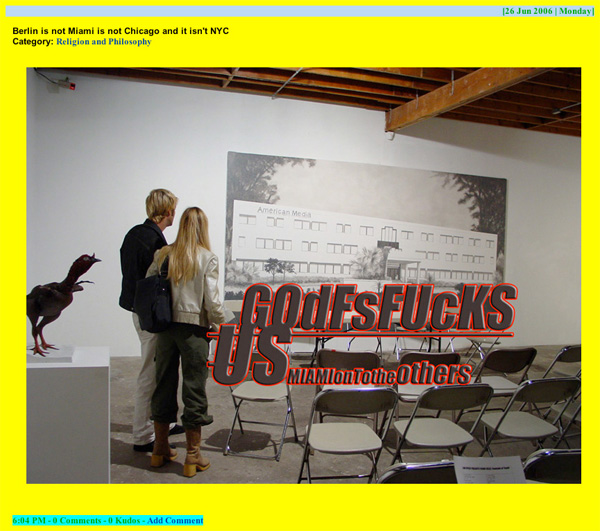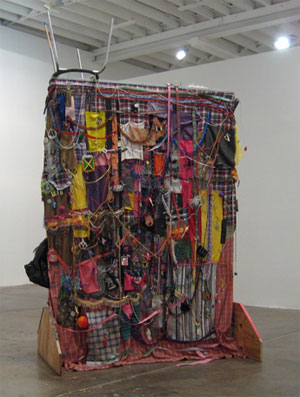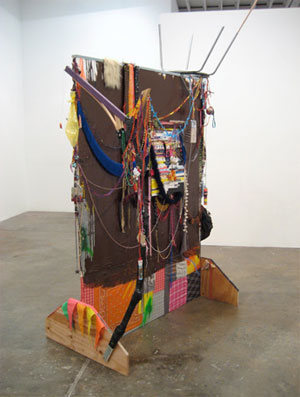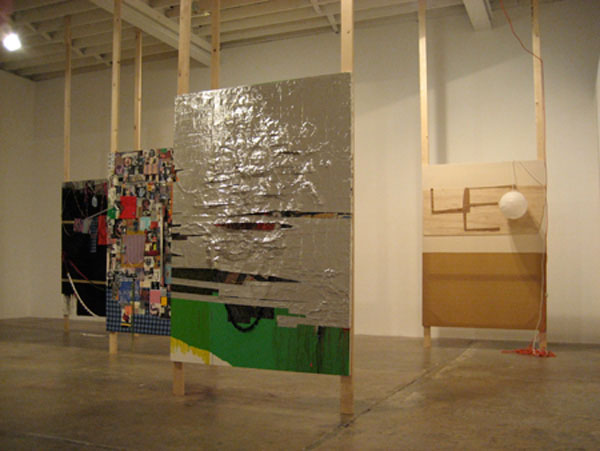|

Two Cards from the Bottom of the DeckSay you’re browsing Myspace. But why on Earth would you be there? We trogs at Rotund World, no matter how long and hard we look at it, feel as aroused by Myspace as we do by the horrifying bacalao over at Migdalia’s reeking kiosk on Loiza. Likely it’s a generational thing. From where we’re sitting, Myspace appears to be a cheesy cyber parlor of idle chatter where the point is to accumulate “friends,” announce a variety of vainglorious aspects of your person such as astrological sign, whether or not you’re dating, your fave bands, grooming habits, drugs of choice, how you stand vis-à-vis tattoos, and so forth, and express something of your innermost being by way of stuttering animated graphics that run the gamut from hard-core to kissy-face. There are a slew of photographic mementos recording extreme, well-dressed arriving, departing, and standing around. Myspace also facilitates instant messaging and commenting, so that the air around any given page thrums with whatever twenty-first century variations of “Dude!” prevail among the pretty vacant, and one sees a lot of put-on luridness that tries very, very hard. There are, we admit, some very cool concert and exhibition posters, and we’re convinced that if you’re in a band Myspace probably beats total obscurity. Judging by what we’ve seen, Myspace belongs perfectly to our increasingly dark ages, in which preening, aggressively knotheaded weblog punditry is ascendant and expressions like “Bite me” stand in for reasoned discourse.
So what is it with the artist’s Myspace pages, called “Hell in LAMB UC”? Is he squirrelier than he looks, happily indulging a skanky fashion du jour? Is he in it for the virtual nookie? Is he putting us on once again? Vélez describes his online exertions as a proposal for an exhibition, but after a more or less painstaking examination of the site—a whole lot less than more, to tell the truth—we’re convinced “Hell in LAMB UC” is the exhibition he’s always wanted. Vélez’s description is, as usual, rife with baloney, especially the earnest yammering about Hunter S. Thompson and William Kennedy, although who knows, he could be serious about this. But more to the point is the artist’s ready willingness to lie: Hell in LAMB UC is a faux over faux multimedia piece housed in the popular web host of My Space.com that investigates the fate of characters, joints and publications found in Hunter S. Thompson lost novel THE RUM DIARY . . . Just like Thompson managed to capture the idiosyncrasies and atmosphere of the hot hub in the Caribbean, Pedro Velez has developed . . . an intricate and non-linear narrative lead by four main characters: Hell in LAMB UC, Ann Lee, Huntergodfs and Staged Metal Party. The four characters introduce the viewer to a web of connections, images, false characters, text and profiles that rips thru the My Space sphere like a manic Gonzo reporter burned with the hot rums of Puerto Rico. “The hot rums of Puerto Rico!” Well. The prose may be purple and the idea overwrought, but “Hell in LAMB UC” is stranger than it looks. For starters, not everything is fiction. Vélez did indeed meet and start dating the woman in the photograph below, during a party at the house pictured. Perhaps the dewy nectars of mutual attraction got uncorked by that very shutter’s click.
But by and large, the pages of his so-called “friends” have that distinctively opaque, quasi-sordid Vélez look, with the notable difference that the author is beginning to show something less than complete indifference to graphic niceties. Staged Metal Party’s “adult REPUBLICANS in jFK” suggests a mouthful, all of it rude, while saying nothing you can put your finger on. It’s as exasperatingly voyeuristic as ever, but considerably more readable than usual, attaining a kind LetraSet piss elegance.
One of Hell in LAMB UC’s own postings is downright elementary Photoshoppy. Good going, Pedro! You have to hand it to Vélez. Even if by happy accident, his suggestive phraseology, compacted and splintered almost beyond verbalization, touches on any number of actual undercurrents of resentment seething at different levels of Puerto Rican society, from sullen youths, to alienated bohemians and would-be bohemians, even into the pained civic consciousness of this conflicted neverland.
What we like about “Hell in LAMB UC” is the way its blog entries and the comments of its “friends” create a convincing, if unwholesome, world of confessional cheap talk, reflexive argumentativeness, and flirting gone wrong. Hunter S. Thompson 6/23/2006 8:24 PM I'm completely confused. For a while it seemed that you wanted literature to be like heavy metal. Heavy metal isn't usually all that smart, but it's passionate, aggressive, sincere, honest, and lacks irony. I could more or less get with that. It seemed right for our post-ironic post 9/11 times. But now you want art to be more like sports? Have you lost your mind?! Sports are all obsessed with competition, corporate sponsorship, advertising, consumerism, and steroid abuse. And you are quoting Nike in your directive to just [fucking] do it? Brother, you have really gone astray. Ann Lee Lives! 6/21/2006 7:30 PM It was very lame, easy and childish of you to give me the 1am, Burger King drive-tru, five minute tops, “I'm so busy and gotta move on,” easy break up and dissappear on the fuckin phone. I would have prefered a letter with you creative use of words, something tangible, and at least, respectful to me, I think I deserved that . . . As you wend your way through the nerve system of Vélez’s semi-fiction, clicking on the friends of friends and their friends, you find an exponentially bigger pool of actual strangers, whose narratives, though not Vélez’s, are no more or less reliable than his. Could anything as deeply weird as the flag-waving Republican Freelancer be made up? Vélez seems to have found, at relatively little expense and bother, a way to have the full- blown exhibition that the art world is always denying him—or so he likes to complain—a show in which he can be as cantankerous, opaque, foul, unhappy, and inventive as he wishes, both enjoying the fruits of an anonymous, profoundly untrustworthy medium while giving it the finger for its superficiality and basic dishonesty. It’s vintage Vélez, only more so. See for yourself at http://myspace.com/hellinlambuc Vélez’s dense, confounding attack—on what we’re not exactly sure, for reasons that pretty much escape us—always puts us in a mind of an old friend in Miami, Gean Moreno. Moreno is an artist, writer, and curator, among other things, but qualifies for us mostly as kind of philosopher of mordant discontent. He is, pound for pound, the equal of Vélez for prickliness, but even more than the boricua contender it seems that any one of Moreno’s callings is just a way to hold the world up to the scrutiny of his formidable intelligence. An exhibition of Moreno’s new work recently opened at Fredric Snitzer Gallery in Miami, and although we were unable to attend, the artist was kind enough to send along some images. We’ve always been pretty much at a loss before the daunting messiness of Moreno’s concoctions, which in recent years have consisted of, in varying proportions, discarded clothing, fuzzy bits, chunks of vintage album covers, strings of plastic jewelry, candy-machine charms, swatches of fabric, extrusions of silicone, broken furniture, daubs of paint, scrap lath and one-by-twos, and much other effluvia that may have emanated from his teenage offspring’s childish pasts, all arranged with so much purpose that there can be no doubt whatsoever that Moreno thinks he knows what it means.
The press release which Moreno himself issued for the show has become part of Miami blog and email legend. We reproduce it below to show you why. José Bedia is one of Miami’s art world deities while Moreno occupies a much more shadowy crevice in the scene’s imagination, and although they could both be seen as “fussy” workers, their production could hardly be more different. The press release has been greeted with unanimous mirth but wildly varying interpretations, and we leave it to you to draw your own conclusions, in which you might be helped by a visit to Miami blog The Next Few Hours where a tasty—and sometimes testy—discussion has been underway for several days. Gean Moreno “Elephant” May 13th - June 12th , 2006 September 9th – October 7th, 2006 Fredric Snitzer Gallery is pleased to present Beyond the press release, we probably should say little about the exhibition itself since, as we mention, we haven’t seen the work en vivo. We did receive this communication from the artist however, and it was his discussion of “Elephant” that got us thinking about him, Pedro Vélez, and some of the eddies in the drift of the contemporary art world. We wrote Moreno that his new work looked in line with the “hodgepodgery” he’s been doing for awhile, and he replied, yeah, definately still hodgepodgery . . . but everything more trashy and more pissed . . . maybe more cynical/uncaring (all pieces, except black zodiac, titled after movies, like “the entity,” an 80s horror/exploitation ditty . . . ) “silver’’ painting in the installation shot is actually a painting that has been “cancelled out”/covered over with cheap foil tape (u know, for a/c units and ducts) . . . also more interest in looking at the “exhibition” as a practice or medium . . . so, the press release was activated (hence the bedia cross out); the hanging or presentation is a little unorthodox (except for the free-standing “black zodiac,” all paintings hang from 2'x4's that have been nailed to the ceiling rafters); the poster was designed by another artist (john espinosa) . . . one of the ideas was to set all the things around the paintings in motion . . . thinking a lot of contexts (where one ends up showing the stuff) and social relations (the kind of things that happen around the paintings) . . .
This willingness to delve into basic assumptions and play with them—taking the art off the walls, work which is perversely abstruse to begin with, and putting it in people’s way—is nothing new. We can almost hear, like a collective sneeze, “Duchamp!” from our deeply vexed readership, some of them barking like dogs, “Barthes! Barthes!” or spitting in our general direction, “Foucault!” or, “It’s the Brazilians, you schmucks!” and pretty much everyone muttering, “Get over it, man.” Truthfully we don’t know what any of these folks are talking about since most of us were home ed or poli-sci majors and the rest pretty much into ingesting fistfuls of illicit substances and lying about on the library lawn ogling the dancing buildings and trees. But we have always been great believers in the adage that timing is everything, and a Moreno poke in the snoot today, even if there’s the stench of very old doings about it, is refreshing in times of the glittery, meaningless surface and the constant, Chinese torture jingle of vast amounts of collectors’ spare change. In other words, what this particular artist does at this very moment makes it different; although just how different only those who were there can say. Perhaps one day Moreno will go to all the trouble he goes to and then seal the gallery before anyone has a chance to see what’s he’s done. In that respect, Pedro Vélez has done Moreno one better in the saintly-devotion-to-his- rasty-vision department. We’ve said it before: to describe Vélez’s installations as “motley” is to just scratch the surface; “off-putting” or “repellent” is probably more like it. The unpleasant posters and banners, the bland flyers with their obvious jokes, the off-kilter walls and nice paintings besmirched by the artist’s crude interventions all seem calculated to disorient, at best, even seasoned gallery goers and to pretty much offend anyone else. When we went to one of his gallery shows and the artist lamented the lack of sales, we thought surely he was joking. “But Pedro,” we wanted to ask him, though we kept it to ourselves, “what, exactly, are people supposed to buy?” Possibly that was the moment when Vélez decided to light out for new and yet more godforsaken territory where one’s work is certain to be appreciated, if not by any buyers then certainly by “friends.” The above images of Moreno's work include, top, two views of “Black Zodiac” (2004-2006, 108" x 64" x 30", mixed media). Below the press release is an installation shot in the front room of Fredric Snitzer Gallery; mixed media works 60" x 84" each. Photographs by William Cordova. ¡La Muestra Nacional de Arte!Friends! It’s that time of the decade, once again, when Puerto Rican cultural officialdom pits generation against generation, brings the conceptualists in contentious proximity with the object makers, and generally raises a stink. But we’ll say no more since a prominent member of the Rotund inner circle “was involved.” We just want to remind you that 13 octubre 2006 is the date of the official opening. Go here to see the highly uncontroversial announcement, and then dust off that frightwig and fish those tight black jeans out from under the bed. ¡Qué bohemio! Return to yesteryear for Noh News here. |

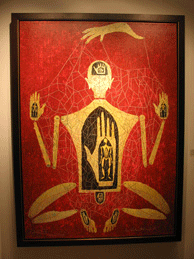
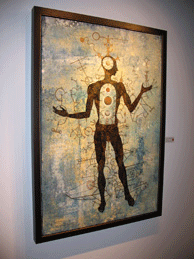
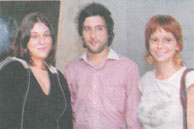
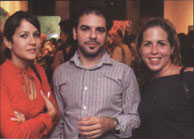

 But herein lies the rub. This is a view of Myspace that you get as you move a little outward from San Juan artist Pedro Vélez’s Myspace pages. If there is one thing we’ve learned in our brief, fraught acquaintanceship with the magmatic Vélez, it’s that he makes a lot of things up. As we’ve pointed out before, his exhibitions include flyers for fake art shows, performances, concerts, and miscellaneous other supposed events and entities, and the tableaux on his posters and banners depict a kind of pained adolescent demimonde to which Vélez, at the age of thirty-four, is not likely to belong no matter how arrested his development. Ditto, his involvement with mainstream artists like Jorge Zeno, a painter who has allowed Vélez to “intervene” on some of his canvases by attaching pieces of paper in the form of almost illegible language, leaves all of us scratching our heads and wondering who is getting what from whom. And why.
But herein lies the rub. This is a view of Myspace that you get as you move a little outward from San Juan artist Pedro Vélez’s Myspace pages. If there is one thing we’ve learned in our brief, fraught acquaintanceship with the magmatic Vélez, it’s that he makes a lot of things up. As we’ve pointed out before, his exhibitions include flyers for fake art shows, performances, concerts, and miscellaneous other supposed events and entities, and the tableaux on his posters and banners depict a kind of pained adolescent demimonde to which Vélez, at the age of thirty-four, is not likely to belong no matter how arrested his development. Ditto, his involvement with mainstream artists like Jorge Zeno, a painter who has allowed Vélez to “intervene” on some of his canvases by attaching pieces of paper in the form of almost illegible language, leaves all of us scratching our heads and wondering who is getting what from whom. And why.